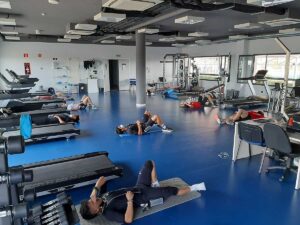In previous posts such as Visceral fat and transaminases, How does WB-EMS training affect body composition? and Improving Body Composition in Men with the WB-EMS, we analyzed the role that WB-EMS training has had on different variables, both health and aesthetic.
Now, in this post, we are going to talk in depth about the type of training we have done, the progression in the electrical load we have applied, and we are going to answer the question: can electrostimulation cause an increase in CK (creatine kinase), or muscle damage? Read on!
Now, in this post we are going to answer the question: Can Electrostimulation cause an increase in CK (creatine kinase), or muscle damage? Keep reading.
CK or creatine kinase is a type of protein and a marker of muscle damage. When we practice extreme training or exercise, it can lead our muscles to “fail”, causing rhabdomyolysis.
Therefore, rhabdomyolysis is caused by an injury or any other condition that causes damage to skeletal muscle.
Electrostimulation training can be very intense, and this has led to the belief that it could cause such muscle damage, and that it may lead to an increase in creatine kinase and, therefore, rhabdomyolysis.
Application of Electrostimulation in Training
In general, EMS has been applied in exercises with very low mobility, practically at isometric exercises and with work-rest cycles of 4 seconds each.
Additionally, traditional EMS does not allow workouts of more than 20 minutes because of the possible muscle damage it may cause. However, this is because the intensities and frequencies used are usually very high and often create discomfort for the individual. In this review by Filipovic and collaborators, they clearly establish which electrostimulation patterns had been used to date (1).

In this sense, we apply an undulating periodization where we work from low frequency 7 Hz, 21 Hz and 33 Hz, to medium and high frequency 33 Hz-100 Hz. Likewise, the work-rest period we use varies between 6 and 30 seconds. However, the intensity we use is very similar to traditional EMS, as we aim for the maximum intensity tolerated by the participant.
Electrostimulation does not elevate creatine kinase
Or in other words, WB-EMS training does not produce or enhance muscle damage.
As mentioned above, one of the reasons why longer EMS times are not usually used is because of the possible muscle damage it may cause. The CK protein or creatine kinase, is a variable that is a marker for muscle damage, and which on some occasions has been excessively elevated after the application of EMS. However, at Wiems Lab we wanted to analyze and disprove this assumption.
After 6 weeks of training for 3 days a week and an average duration of 45 minutes, we found no increase in blood CK or creatine kinase.
Pre-training CK protein blood values were 150 U/L and 151 U/L respectively in a middle-aged man and a middle-aged woman.
In the male case, another blood draw was performed at week 4 with a value of 158 U/L. Finally, after 6 weeks, both participants had CK values of 155 U/L and 157 U/L. These values are entirely normative, and there is no significant increase in CK protein after training.
The training protocol we follow not only with the above mentioned success story, but also with other clients working with Wiems Pro, combines a set of frequencies, intensities and work-rest period. Here is a sample day, but you can also download the 6-week training.

Conclusion
Our work philosophy and what makes us stand out is that we believe in a different application of EMS.
At Wiems Lab, we confirm and conclude that electrostimulation does not cause a significant increase in CK protein. Despite having previously dealt with clients and not having discovered any physical discomfort, this study shows that WB-EMS used as we do at Wiemspro does not cause muscle damage.
The type of undulating planning that we use does not cause any health problems in the individual and does plenty to improve health and well-being.
Unai Adrian Perez de Arrilucea
Abraham Carlé Calo
Wiems Lab Team







